Midsummers Past – Remembering Dunderry
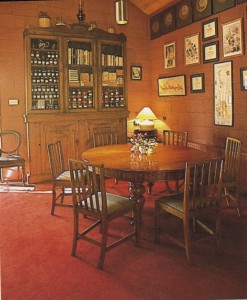 Ah, midsummer’s day. It may be a wet and blustery summer solstice today, but this is the time when memories of the halcyon days of Dunderry Lodge are most poignant, those heady evenings in the 1980s when we would plan to make full use of the lingering daylight for an expedition to our favourite restaurant.
Ah, midsummer’s day. It may be a wet and blustery summer solstice today, but this is the time when memories of the halcyon days of Dunderry Lodge are most poignant, those heady evenings in the 1980s when we would plan to make full use of the lingering daylight for an expedition to our favourite restaurant.
Mulling over the last wonderful meal there, and guessing what might be on tonight, we’d sweep up through the majestically tree-lined roads of Meath, past the derelict sheds on the corner and into the gravelled carpark at the old farm that the late Nick and Catherine Healy had converted to create their simple yet sophisticated restaurant.
Unlike the formal city restaurants of the time, it had rustic charm to match the assured simplicity of Catherine’s cooking and Nick’s knowledge of wine, earning them coveted membership of the Irish Country Houses & Restaurants Association (now Ireland’s Blue Book) and countless accolades including a Michelin star from 1986 until they sold the restaurant in 1990, when Catherine became ill.
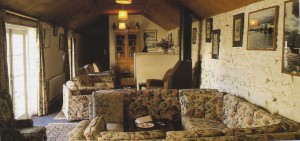 Like the Allens at Ballymaloe House, they were light years ahead of their time in so many ways at Dunderry. Fruit, vegetables and herbs were grown in a constantly expanding plot beside the car park, giving the arriving diners a fair idea of what was at its best and likely to star on the menu. They grew produce that was unusual for the time, and they were foragers too; they’d have felt very much at home at Noma, I suspect.
Like the Allens at Ballymaloe House, they were light years ahead of their time in so many ways at Dunderry. Fruit, vegetables and herbs were grown in a constantly expanding plot beside the car park, giving the arriving diners a fair idea of what was at its best and likely to star on the menu. They grew produce that was unusual for the time, and they were foragers too; they’d have felt very much at home at Noma, I suspect.
Interestingly, when Sir Clement Freud selected the restaurants to feature in his book ‘The Gourmet’s Tour of Great Britain and Ireland’ (Little Brown, 1989), he included only two in Ireland: Ballymaloe House and Dunderry Lodge. That says it all really, but his piece is well worth seeking out as it captures perfectly the essence of Dunderry.
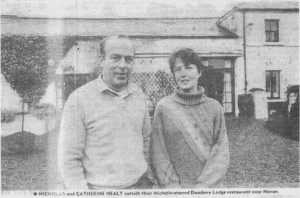 It is also a little mischievous and includes our favourite description of Nick Healy at work, front of house: “Nicholas was a professional caterer, knows just how it should all be done and frightens the living daylights out of many of his customers, who come back regardless. Like many of us who are or were in the trade, he realises that if a punter is left on edge he will be less likely to make a fuss, that much easier to serve. He corrects the pronuciation of a French wine to one party, taps his pen against his pad as another table is deciding what to order for pudding, raises his eyebrow as someone orders red wine with lobster, generally keeps the clientèle up to the mark…but win him over and you will not find a pleasanter man in the country.”
It is also a little mischievous and includes our favourite description of Nick Healy at work, front of house: “Nicholas was a professional caterer, knows just how it should all be done and frightens the living daylights out of many of his customers, who come back regardless. Like many of us who are or were in the trade, he realises that if a punter is left on edge he will be less likely to make a fuss, that much easier to serve. He corrects the pronuciation of a French wine to one party, taps his pen against his pad as another table is deciding what to order for pudding, raises his eyebrow as someone orders red wine with lobster, generally keeps the clientèle up to the mark…but win him over and you will not find a pleasanter man in the country.”
Catherine, a mainly self-taught cooked who upped the ante at Dunderry hugely by spending working holidays with some of Europe’s finest chefs (notably Roger Vergé at the Moulin de Mougins on the Cote d’Azur), died in 1993, and Nick followed her this year, on 1st June. I last saw him a few days previously at St Francis Hospice, Raheny, with a hardback copy of Elizabeth David’s French Provincial Cooking in his hand and a broad smile on his face. A happy memory – just like those of their heyday at Dunderry Lodge.
RECIPES: These two recipes given in ‘The Gourmet’s Tour of Great Britain and Ireland’ illustrate the simple elegance of Catherine Healy’s cooking style, and (unlike most chefs’ recipes), they are not difficult to follow.
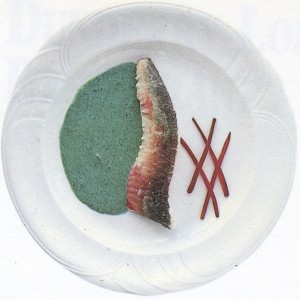 Dunderry Lodge fillet of gurnard with a nettle sauce
Dunderry Lodge fillet of gurnard with a nettle sauce
1 cup nettle leaves from young nettles, without stalks
7 fl oz (200 ml) fish stock
7 fl oz(200 ml) double cream
salt and freshly ground pepper
6 fillets red gurnard, each 6 oz (170 g)
red chard, cut into julienne strips
Serves 6
To make the nettle purée, plunge the nettle leaves into boiling water and continue boiling until the leaves are quite soft, this will only take 3-5 minutes. Drain, then push the leaves through; sieve to form a good purée.
Place the fish stock and cream in a saucepan, bring to the boil and reduce until the mixture coats the back of a spoon. Season lightly with salt and pepper, then stir in the nettle purée.
Place the gurnard fillets in a steamer, skin side uppermost, and steam for 5 minutes. Spoon the nettle sauce onto the serving plates, arrange the gurnard fillets on top and garnish with the Julienne ofred chard.
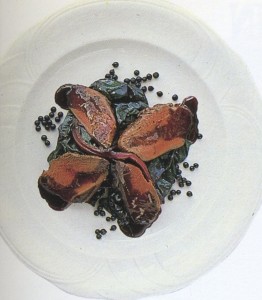 Dunderry Lodge breast of pigeon with red chard, sauce Beaujolais
Dunderry Lodge breast of pigeon with red chard, sauce Beaujolais
6 plump pigeons
red chard leaves (use green if red unavailable)
bottle beaujolais
1 teaspoon balsamic vinegar
butter
Serves 6
Planning ahead: The stock can be made 1 day in advance.
Draw and clean the pigeons. Remove the breasts and reserve. Use the carcases to make a good stock. Blanch the chard leaves and keep in iced water until needed. Strain the pigeon stock to a saucepan and add the red wine. Bring to the boil, then simmer until the sauce is a good consistency. Add the balsamic vinegar and cook for a further few minutes. Whisk in a little butter and keep warm until ready serve.
Lightly pan-fry the pigeon breasts in a little butter. Warm up the chard leaves in a little butter, then arrange on the serving plates. Place the pigeon breasts on top, pour over the sauce and serve immediately.








